Effects of the Incorporation of Calcium Chloride on the Physical and Oxidative Stability of Filled Hydrogel Particles
Abstract
:1. Introduction
2. Materials and Methods
2.1. Materials
2.2. Preparation of the O/W Emulsion
2.3. Phase Separation Products Preparation
2.4. Fabrication of the Filled Hydrogel
2.5. Particle Size and Zeta-Potential
2.6. Rheological Behavior
2.6.1. Flow Behavior
2.6.2. Dynamic Viscoelastic Measurements
2.7. Interfacial Layer Thickness
2.8. Colour Measurement
2.9. Morphology Analysis
2.10. Lipid Oxidation
2.11. Protein Oxidation Measurements
2.12. Statistical Analyses
3. Results and Discussion
3.1. Particle Size
3.2. Zeta-Potential
3.3. Apparent Viscosity
3.4. Dynamic Rheological Behavior
3.5. Color Analysis
3.6. Interfacial Layer Thickness
3.7. Surface Characterization of Droplets
3.8. Lipid Oxidation
3.9. Protein Oxidation
3.10. Correlation between Physical and Oxidative Stability
4. Conclusions
Author Contributions
Funding
Institutional Review Board Statement
Informed Consent Statement
Data Availability Statement
Conflicts of Interest
References
- Matalanis, A.; McClements, D.J. Influencing the formation and stability of filled hydrogel particles fabricated by protein/polysaccharide phase separation and enzymatic cross-linking. Food Biophys. 2012, 7, 72–83. [Google Scholar] [CrossRef]
- Berendsen, R.; Güell, C.; Ferrando, M. A procyanidin-rich extract encapsulated in water-in-oil-in-water emulsions produced by premix membrane emulsification. Food Hydrocolloid. 2015, 43, 636–648. [Google Scholar] [CrossRef]
- Cao, C.A.; Zhao, S.C.; Chen, J.X.; Wang, H.; Liu, Q.; Kong, B.H. Physical properties and stability of filled hydrogel particles based on biopolymer phase separation: Influence of the ratio of protein to polysaccharide. Int. J. Biol. Macromol. 2020, 142, 803–810. [Google Scholar] [CrossRef]
- Matalanis, A.; Lesmes, U.; Decker, E.A.; McClements, D.J. Fabrication and characterization of filled hydrogel particles based on sequential segregative and aggregative biopolymer phase separation. Food Hydrocolloid. 2010, 24, 689–701. [Google Scholar] [CrossRef]
- Matalanis, A.; McClements, D.J. Hydrogel microspheres for encapsulation of lipophilic components: Optimization of fabrication and performance. Food Hydrocolloid. 2013, 31, 15–25. [Google Scholar] [CrossRef]
- Kim, H.J.; Decker, E.A.; McClements, D.J. Preparation of multiple emulsions based on thermodynamic incompatibility of heat-denatured whey protein and pectin solutions. Food Hydrocolloid. 2006, 20, 586–595. [Google Scholar] [CrossRef]
- Malone, M.E.; Appelqvist, I.A.M. Gelled emulsion particles for the controlled release of lipophilic volatiles during eating. J. Control. Release 2003, 90, 227–241. [Google Scholar] [CrossRef]
- Garti, N.; Benichou, A. Recent developments in double emulsions for food applications. In Food Emulsions, 4th ed.; Friberg, S.E., Larsson, K., Sjoblom, J., Eds.; Marcel Dekker: New York, NY, USA, 2004. [Google Scholar]
- Ling, Z.T.; Ai, M.M.; Zhou, Q.; Guo, S.G.; Zhou, L.D.; Fan, H.; Cao, Y.Y.; Jiang, A.M. Fabrication egg white gel hydrolysates-stabilized oil-in-water emulsion and characterization of its stability and digestibility. Food Hydrocolloid. 2020, 102, 105621. [Google Scholar] [CrossRef]
- Cai, X.R.; Du, X.F.; Zhu, G.L.; Cao, C. Induction effect of NaCl on the formation and stability of emulsions stabilized by carboxymethyl starch/xanthan gum combinations. Food Hydrocolloid. 2020, 105, 105776. [Google Scholar] [CrossRef]
- Wang, W.J.; Shen, M.Y.; Liu, S.C.; Jiang, L.; Song, Q.Q.; Xie, J.H. Gel properties and interactions of Mesona blumes polysaccharide-soy protein isolates mixed gel: The effect of salt addition. Carbohyd. Polym. 2018, 192, 193–201. [Google Scholar] [CrossRef]
- Kilan, K.; Warszynski, P. Thickness and permeability of multilayers containing alginate cross-linked by calcium ions. Electrochim. Acta 2014, 144, 254–262. [Google Scholar] [CrossRef]
- Barone, G.; Moloney, C.; O’Regan, J.; Kelly, A.L.; O’Mahony, J.A. Influence of calcium fortification on physicochemical properties of whey protein concentrate solutions enriched in α-lactalbumin. Food Chem. 2020, 317, 126412. [Google Scholar] [CrossRef]
- Xiao, Y.Q.; Kang, S.F.; Liu, Y.N.; Guo, X.Y.; Li, M.; Xu, H.D. Effect and mechanism of calcium ions on the gelation properties of cellulose nanocrystals-whey protein isolate composite gels. Food Hydrocolloid. 2021, 111, 106401. [Google Scholar] [CrossRef]
- Du, Q.W.; Ji, X.H.; Lyu, F.; Liu, J.H.; Jing, Y.T. Heat stability and rheology of high-calorie whey protein emulsion: Effects of calcium ions. Food Hydrocolloid. 2021, 114, 106583. [Google Scholar] [CrossRef]
- Ren, W.B.; Zhao, S.J.; Lian, Y.H.; Yang, Y.; Tian, G.F.; Zhao, C.Y.; Gao, W.; Zheng, J.K. Effects of hydrosoluble calcium ions and organic acids on citrus oil emulsions stabilized with citrus pectin. Food Hydrocolloid. 2020, 100, 105413. [Google Scholar] [CrossRef]
- Hinderink, E.B.A.; Schröder, A.; Sagis, L.; Schroën, K.; Berton-Carabin, C.C. Physical and oxidative stability of food emulsions prepared with pea protein fractions. LWT-Food Sci. Technol. 2021, 146, 111424. [Google Scholar] [CrossRef]
- Wong, B.T.; Day, L.; Augustin, M.A. Deamidated wheat protein-dextran Maillard conjugates: Effect of size and location of polysaccharide conjugated on steric stabilization of emulsions at acidic pH. Food Hydrocolloid. 2011, 25, 1424–1432. [Google Scholar] [CrossRef]
- Cao, C.A.; Feng, Y.Y.; Kong, B.H.; Sun, F.D.; Yang, L.; Liu, Q. Transglutaminase crosslinking promotes physical and oxidative stability of filled hydrogel particles based on biopolymer phase separation. Int. J. Biol. Macromol. 2021, 172, 429–438. [Google Scholar] [CrossRef]
- Corongiu, F.P.; Banni, S. Detection of conjugated dienes by second derivative ultraviolet spectrophotometry. Method. Enzymol. 1994, 233, 303–310. [Google Scholar] [CrossRef]
- Mcdonald, R.E.; Hultin, H.O. Some characteristics of the enzymic lipid peroxidation system in the microsomal fraction of flounder skeletal muscle. J. Food Sci. 1987, 52, 15–21. [Google Scholar] [CrossRef]
- Low, L.E.; Siva, S.P.; Ho, Y.K.; Chan, E.S.; Tey, B.T. Recent advances of characterization techniques for the formation, physical properties and stability of Pickering emulsion. Adv. Colloid Interface Sci. 2020, 277, 102117. [Google Scholar] [CrossRef]
- Keowmaneechai, E.; Mcclements, D.J. Effect of CaCl2 and KCl on physiochemical properties of model nutritional beverages based on whey protein stabilized oil-in-water emulsions. J. Food Sci. 2010, 67, 665–671. [Google Scholar] [CrossRef]
- Mat Yusoff, M.; Gordon, M.H.; Niranjan, K. Aqueous enzyme assisted oil extraction from oilseeds and emulsion de-emulsifying methods: A review. Trends Food Sci. Technol. 2015, 41, 60–82. [Google Scholar] [CrossRef]
- Mokni, G.A.; Sila, A.; Maklouf, G.I.; Blecker, C.; Danthines, S.; Attia, H.; Bougatef, A.; Besbes, S. Structural, functional, and ACE inhibitory properties of water-soluble polysaccharides from chickpea flours. Int. J. Biol. Macromol. 2015, 75, 276–282. [Google Scholar] [CrossRef]
- Baumy, J.; Brule, G. Binding of bivalent cations to α-lactalbumin and β-lactoglobulin: Effect of pH and ionic strength. Le Lait 1988, 68, 33–48. [Google Scholar] [CrossRef]
- Li, S.; Donner, E.; Thompson, M.; Zhang, Y.; Rempel, C.; Qiang, L. Preparation of branched canola protein isolate and effects of molecular architecture on solution flow properties. LWT-Food Sci. Technol. 2017, 79, 287–293. [Google Scholar] [CrossRef]
- Westerik, N.; Scholten, E.; Corredig, M. The effect of calcium on the composition and physical properties of whey protein particles prepared using emulsification. Food Chem. 2015, 177, 72–80. [Google Scholar] [CrossRef]
- Guo, X.H.; Wu, D.; Zhou, B.; Chen, Z.; Li, B.J.; Wang, S.H.; Pei, Y.Q.; Li, B.; Liang, H.S. Reinforced pickering emulsions stabilized by desalted duck egg white nanogels with Ca2+ as binding agents. Food Hydrocolloid. 2021, 121, 106974. [Google Scholar] [CrossRef]
- Luo, K.Y.; Liu, S.T.; Miao, S.; Adhikari, B.; Wang, X.F.; Chen, J. Effects of transglutaminase pre-crosslinking on salt-induced gelation of soy protein isolate emulsion. J. Food Eng. 2019, 263, 280–287. [Google Scholar] [CrossRef]
- Fan, M.; Nie, C.; Du, H.; Ni, J.; Wang, B.; Wang, X. An insight into the solar demulsification of highly emulsified water produced from oilfields by monitoring the viscosity, zeta potential, particle size and rheology. Colloid. Surf. A 2019, 575, 144–154. [Google Scholar] [CrossRef]
- Taha, A.; Ahmed, E.; Hu, T.; Xu, X.Y.; Pan, S.Y.; Hu, H. Effects of different ionic strengths on the physicochemical properties of plant and animal proteins-stabilized emulsions fabricated using ultrasound emulsification. Ultrason. Sonochem. 2019, 58, 104627. [Google Scholar] [CrossRef] [PubMed]
- Wijaya, W.; Zheng, H.; Patel, A.R.; der Meeren, P.; Huang, Q.R. Crystallization of polymethoxyflavones in high internal phase emulsions stabilized using biopolymeric complexes: Implications for microstructure and in vitro digestion properties. Food Biosci. 2021, 40, 100876. [Google Scholar] [CrossRef]
- Liang, X.P.; Ma, C.C.; Yan, X.J.; Zeng, H.H.; McClements, D.J.; Liu, X.B.; Liu, F.G. Structure, rheology and functionality of whey protein emulsion gels: Effects of double cross-linking with transglutaminase and calcium ions. Food Hydrocolloid. 2020, 102, 105569. [Google Scholar] [CrossRef]
- Chung, C.; Degner, B.; Decker, E.A.; McClements, D.J. Oil-filled hydrogel particles for reduced-fat food applications: Fabrication, characterization, and properties. Innov. Food Sci. Emerg. Technol. 2013, 20, 324–333. [Google Scholar] [CrossRef]
- Coupland, J.N.; McClements, D.J. Lipid oxidation in food emulsions. Trends Food Sci. Technol. 1996, 7, 83–91. [Google Scholar] [CrossRef]
- Griffin, K.; Khouryieh, H. Influence of electrostatic interactions on the formation and stability of multilayer fish oil-in-water emulsions stabilized by whey protein-xanthan-locust bean complexes. J. Food Eng. 2019, 277, 109893. [Google Scholar] [CrossRef]
- Garcíamoreno, P.J.; Guadix, A.; Guadix, E.M.; Jacobsen, C. Physical and oxidative stability of fish oil-in-water emulsions stabilized with fish protein hydrolysates. Food Chem. 2016, 203, 124–135. [Google Scholar] [CrossRef] [Green Version]
- Zhong, M.M.; Sun, Y.F.; Sun, Y.D.; Huang, Y.Y.; Qi, B.K.; Li, Y. The effect of salt ion on the freeze-thaw stability and digestibility of the lipophilic protein-hydroxypropyl methylcellulose emulsion. LWT-Food Sci. Technol. 2021, 151, 112202. [Google Scholar] [CrossRef]
- Sun, W.Z.; Zhou, F.B.; Sun, D.W.; Zhao, M.M. Effect of oxidation on the emulsifying properties of myofibrillar proteins. Food Bioprocess Technol. 2013, 6, 1703–1712. [Google Scholar] [CrossRef]
- Xu, M.F.; Lian, Z.H.; Chen, X.Q.; Yao, X.; Lu, C.R.; Niu, X.Y.; Xu, M.J.; Zhu, Q. Effects of resveratrol on lipid and protein co-oxidation in fish oil-enriched whey protein isolate emulsions. Food Chem. 2021, 365, 130525. [Google Scholar] [CrossRef]
- Estéveza, M.; Kyllia, P.; Puolanneb, E.; Kivikaria, R.; Heinonena, M. Fluorescence spectroscopy as a novel approach for the assessment of myofibrillar protein oxidation in oil-in-water emulsions. Meat Sci. 2008, 80, 1290–1296. [Google Scholar] [CrossRef] [PubMed]
- Dean, R.T.; Shanlin, F.U.; Stocker, R.; Davies, M.J. Biochemistry and pathology of radical mediated protein oxidation. Biochem. J. 1997, 324, 360–369. [Google Scholar] [CrossRef] [Green Version]
- Lund, M.N.; Heinonen, M.; Baron, C.P.; Est’evez, M. Protein oxidation in muscle foods: A review. Mol. Nutr. Food Res. 2011, 55, 83–95. [Google Scholar] [CrossRef] [PubMed]
- Berton-Carabin, C.C.; Ropers, M.-H.; Genot, C. Lipid oxidation in oil-in-water emulsions: Involvement of the interfacial layer. Compr. Rev. Food Sci. Food Saf. 2014, 13, 945–977. [Google Scholar] [CrossRef]
- Liu, C.; Pei, R.S.; Heinonen, M. Faba bean protein: A promising plant-based emulsifier for improving physical and oxidative stabilities of oil-in-water emulsions. Food Chem. 2022, 369, 130879. [Google Scholar] [CrossRef]

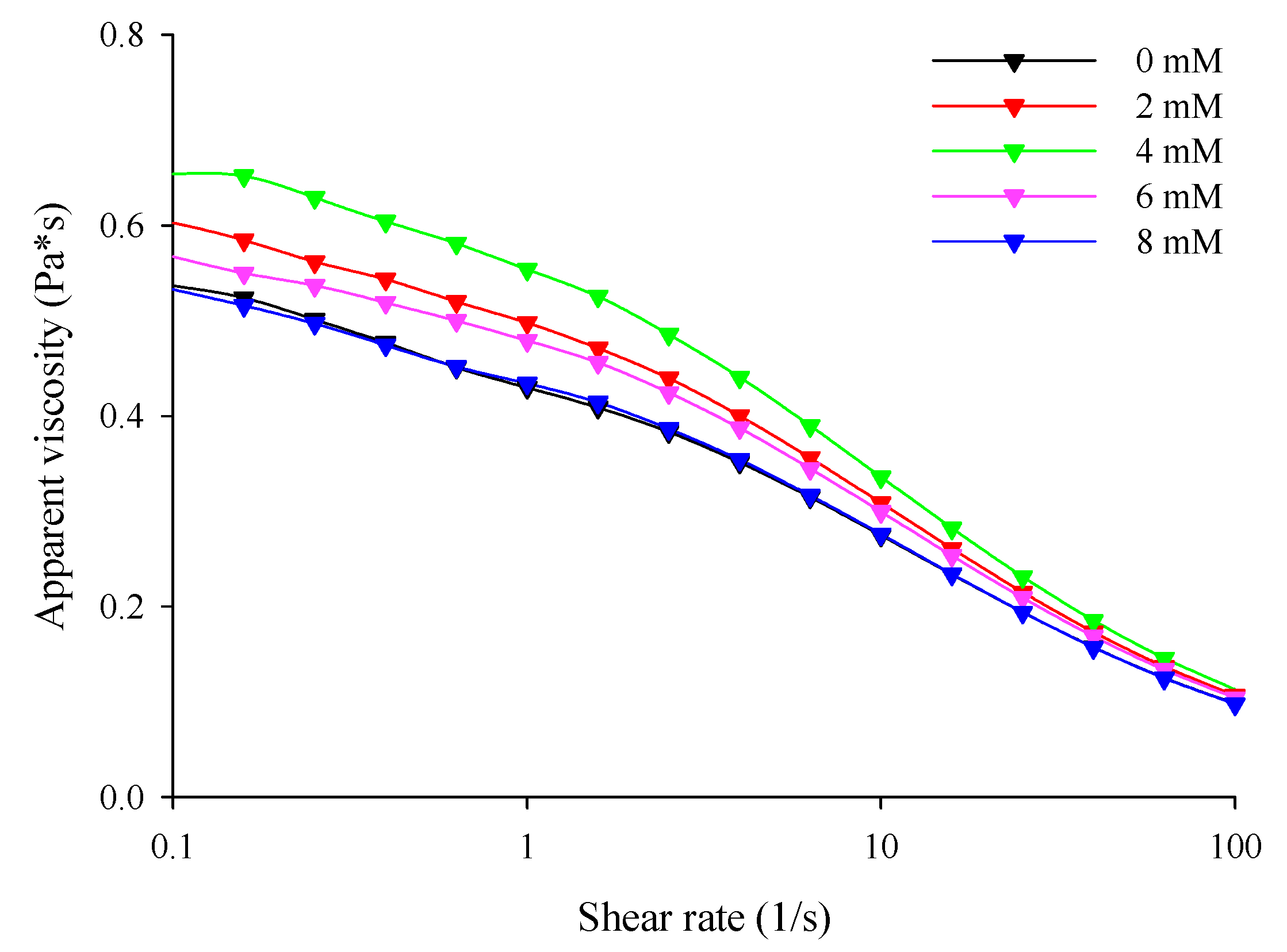
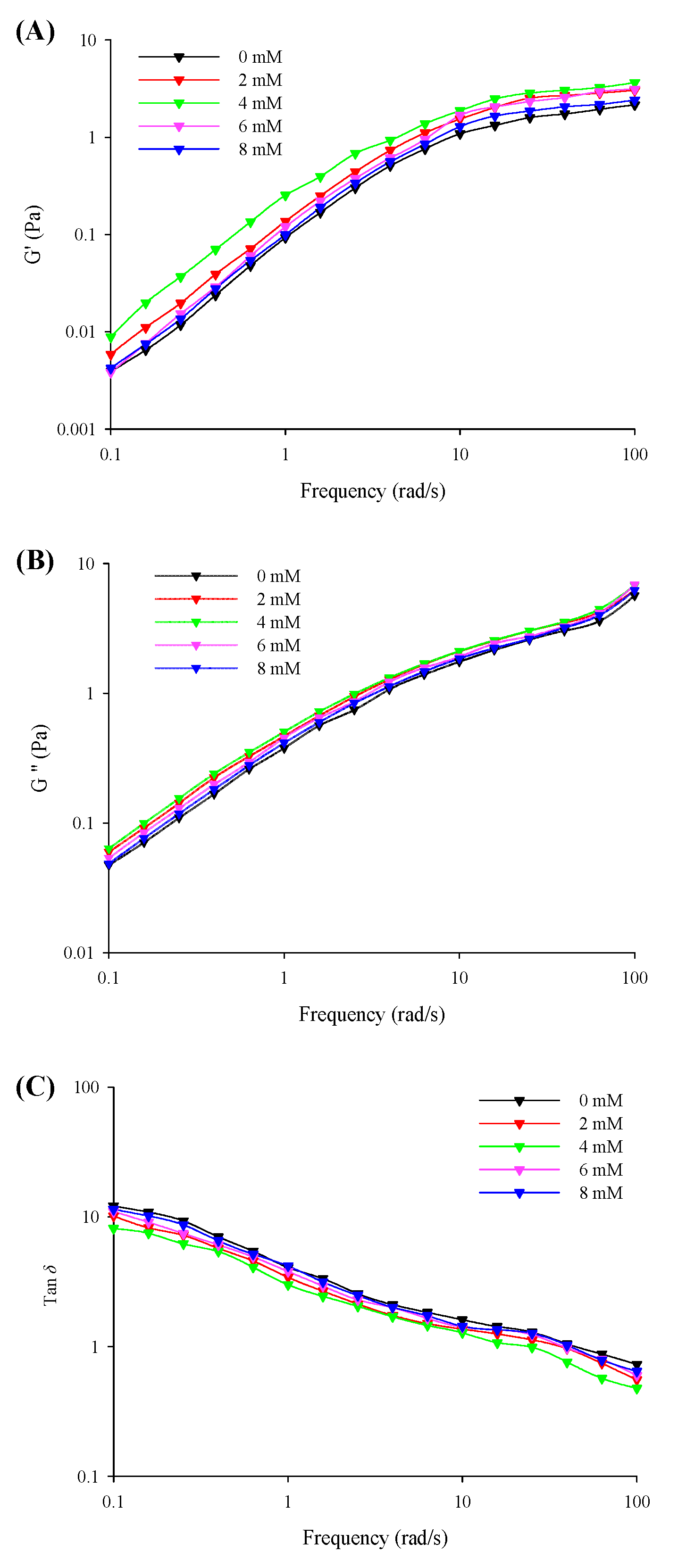
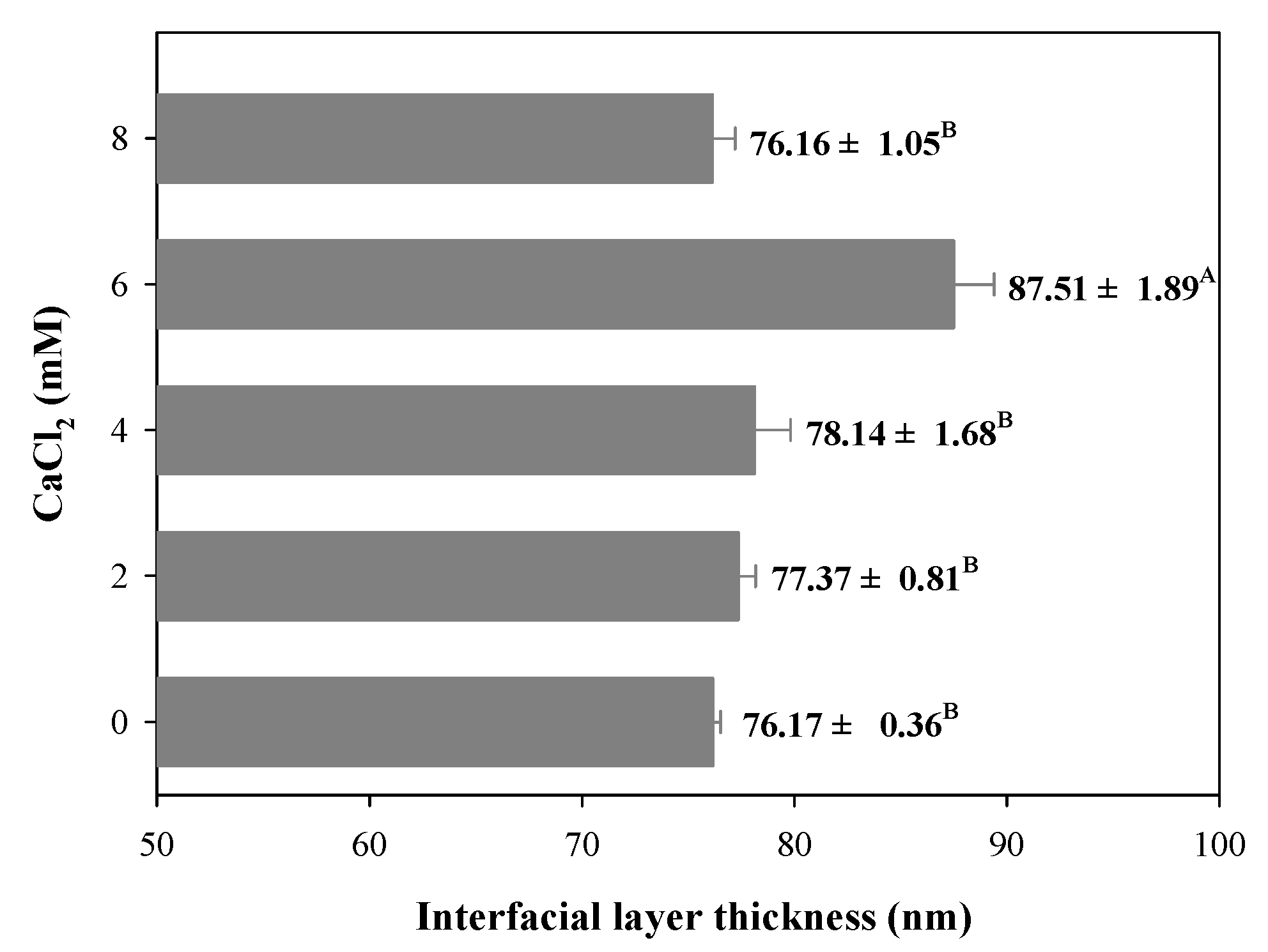
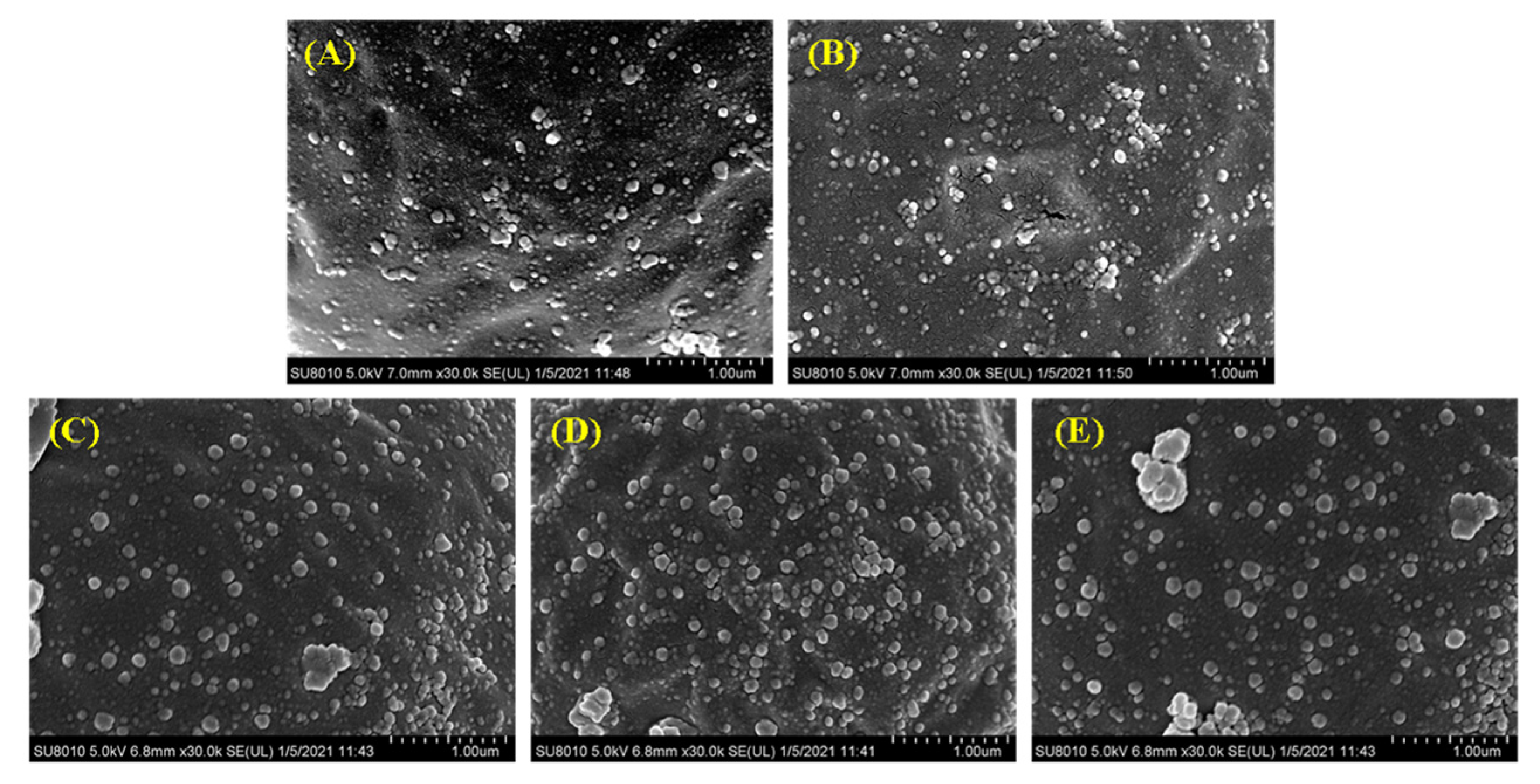
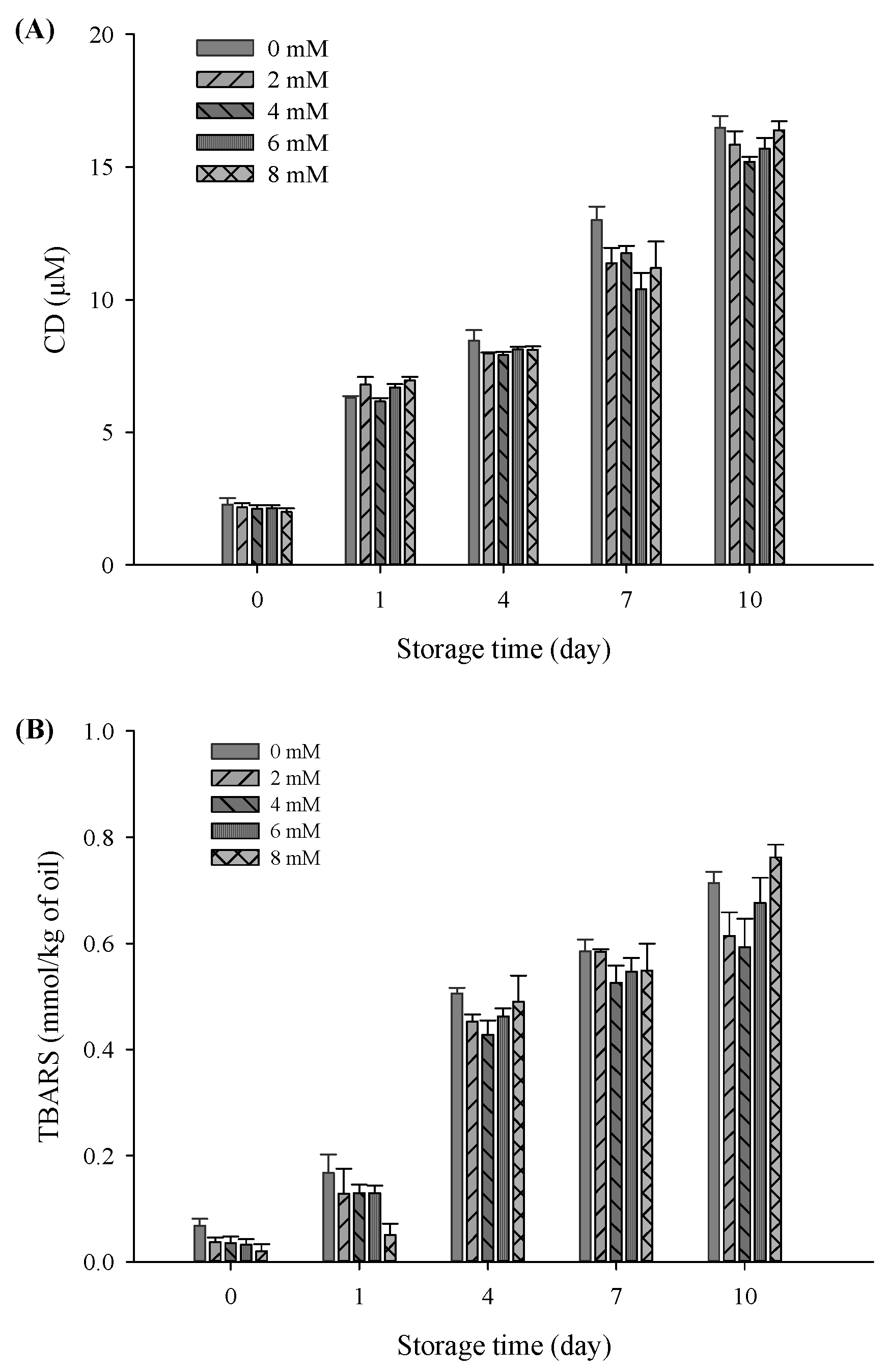
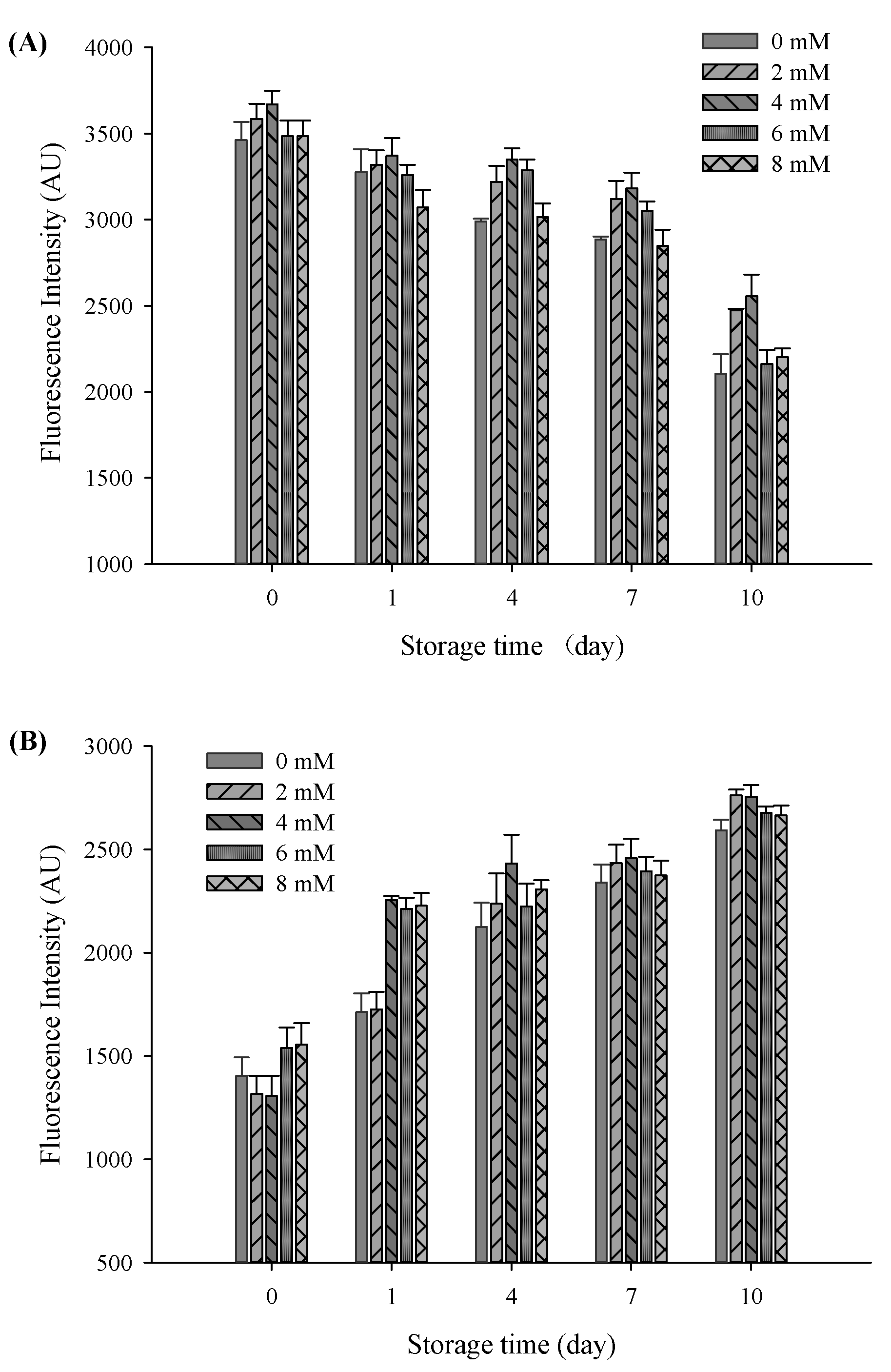
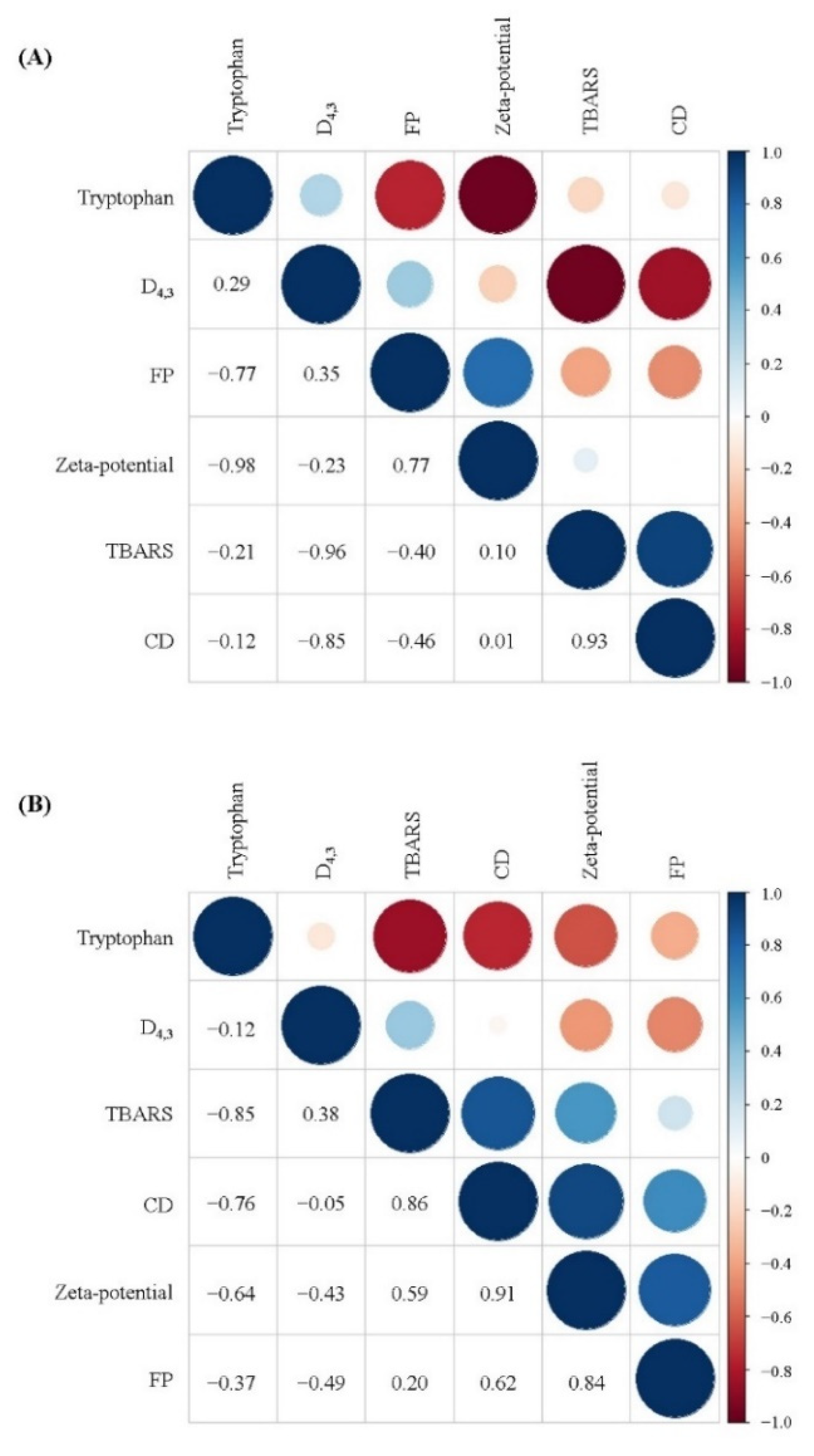
| CaCl2 (mM) | The Volume Averaged Diameter (D4,3, μm) | Increased Rate (%) | The Surface-Averaged Diameter (D3,2, μm) | Increased Rate (%) | ||
|---|---|---|---|---|---|---|
| Day 0 | Day 10 | Day 0 | Day 10 | |||
| 0 | 24.97 ± 0.93 B | 31.64 ± 0.95 C | 26.74 ± 0.91 A | 5.40 ± 0.05 C | 10.13 ± 0.07 D | 87.60 ± 0.44 A |
| 2 | 27.23 ± 0.54 AB | 33.10 ± 0.67 BC | 21.56 ± 0.05 B | 5.76 ± 0.03 B | 10.39 ± 0.10 C | 80.38 ± 0.80 C |
| 4 | 27.96 ± 0.80 A | 33.51 ± 0.96 BC | 19.85 ± 0.01 B | 5.81 ± 0.05 B | 10.66 ± 0.06 B | 83.48 ± 0.55 B |
| 6 | 28.31 ± 1.13 A | 35.05 ± 0.44 AB | 21.35 ± 2.19 B | 5.98 ± 0.04 A | 10.91 ± 0.10 A | 82.44 ± 0.45 B |
| 8 | 28.40 ± 0.99 A | 36.06 ± 1.34 A | 26.97 ± 0.29 A | 6.03 ± 0.07 A | 11.02 ± 0.12 A | 82.75 ± 0.13 B |
| CaCl2 (mM) | Zeta-Potential (mV) | |
|---|---|---|
| Day 0 | Day 10 | |
| 0 | −32.13 ± 0.51 B | −26.65 ± 0.14 C |
| 2 | −33.10 ± 0.27 AB | −27.83 ± 0.60 BC |
| 4 | −34.30 ± 0.53 A | −29.38 ± 0.49 A |
| 6 | −32.40 ± 0.69 B | −28.58 ± 0.09 AB |
| 8 | −32.00 ± 0.70 B | −27.86 ± 0.77 BC |
| CaCl2 (mM) | Zero-Shear Viscosity | The Time Constant (λ) | The Dimensionless Exponent (m) | The Correlation Coefficient (R2) |
|---|---|---|---|---|
| 0 | 0.5364 ± 0.0015 D | 0.2365 ± 0.0006 A | 0.4742 ± 0.0011 D | 0.9876 |
| 2 | 0.6035 ± 0.0006 B | 0.1258 ± 0.0009 C | 0.6037 ± 0.0009 B | 0.9968 |
| 4 | 0.6543 ± 0.0022 A | 0.0817 ± 0.0007 D | 0.8254 ± 0.0010 A | 0.9774 |
| 6 | 0.5683 ± 0.0013 C | 0.1534 ± 0.0006 B | 0.5265 ± 0.0014 C | 0.9878 |
| 8 | 0.5323 ± 0.0012 E | 0.2385 ± 0.0001 A | 0.4677 ± 0.0010 E | 0.9829 |
| CaCl2 (mM) | log G′ = log a′ + b′·log f | log G″ = log a″ + b″·log f | ||||
|---|---|---|---|---|---|---|
| The Model Parameters (a′) | The Dimensionless Frequency Indices (b′) | R2 | The Model Parameters (a″) | The Dimensionless Frequency Indices (b″) | R2 | |
| 0 | 0.0784 ± 0.0039 E | 1.2806 ± 0.0012 B | 0.9934 | 0.3170 ± 0.0211 C | 0.6695 ± 0.0014 A | 0.9764 |
| 2 | 0.1191 ± 0.0021 B | 1.2493± 0.0023 C | 0.9940 | 0.3952 ± 0.0247 AB | 0.6490 ± 0.0021 C | 0.9745 |
| 4 | 0.1877 ± 0.0034 A | 1.1666 ± 0.0025 D | 0.9830 | 0.4186 ± 0.0123 A | 0.6412 ± 0.0019 D | 0.9756 |
| 6 | 0.0976 ± 0.0037 C | 1.3280 ± 0.0019 A | 0.9944 | 0.3655± 0.0302 ABC | 0.6631 ± 0.0023 B | 0.9763 |
| 8 | 0.0882± 0.0027 D | 1.2836 ± 0.0011 B | 0.9948 | 0.3384 ± 0.0124 BC | 0.6698 ± 0.0027 A | 0.9759 |
| CaCl2 (mM) | L* Value | a* Value | b* Value | Whiteness |
|---|---|---|---|---|
| 0 | 59.51 ± 0.54 A | −2.10 ± 0.01 A | −2.45 ± 0.21 A | 59.67 ± 0.04 A |
| 2 | 59.40 ± 0.28 A | −2.17 ± 0.02 A | −2.51 ± 0.16 A | 59.23 ± 0.11 AB |
| 4 | 57.82 ± 0.61 B | −2.21 ± 0.07 A | −2.62 ± 0.10 A | 58.34 ± 0.11 C |
| 6 | 56.73 ± 0.56 BC | −2.28 ± 0.09 A | −2.68 ± 0.02 B | 57.67 ± 0.07 C |
| 8 | 55.89 ± 0.31 C | −2.31 ± 0.05 A | −2.69 ± 0.06 A | 56.09 ± 0.25 D |
Publisher’s Note: MDPI stays neutral with regard to jurisdictional claims in published maps and institutional affiliations. |
© 2022 by the authors. Licensee MDPI, Basel, Switzerland. This article is an open access article distributed under the terms and conditions of the Creative Commons Attribution (CC BY) license (https://creativecommons.org/licenses/by/4.0/).
Share and Cite
Li, X.; Cao, C.; Yuan, D.; Liu, Q.; Zhao, J. Effects of the Incorporation of Calcium Chloride on the Physical and Oxidative Stability of Filled Hydrogel Particles. Foods 2022, 11, 278. https://doi.org/10.3390/foods11030278
Li X, Cao C, Yuan D, Liu Q, Zhao J. Effects of the Incorporation of Calcium Chloride on the Physical and Oxidative Stability of Filled Hydrogel Particles. Foods. 2022; 11(3):278. https://doi.org/10.3390/foods11030278
Chicago/Turabian StyleLi, Xin, Chuanai Cao, Dongxue Yuan, Qian Liu, and Jinhai Zhao. 2022. "Effects of the Incorporation of Calcium Chloride on the Physical and Oxidative Stability of Filled Hydrogel Particles" Foods 11, no. 3: 278. https://doi.org/10.3390/foods11030278







